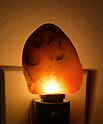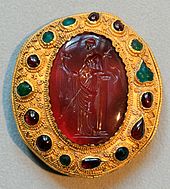Carnelian
| Carnelian | |
|---|---|
 | |
| General | |
| Category | Chalcedonyvariety |
| Formula (repeating unit) | SiO2(silicon dioxide) |
| Crystal system | Trigonal |
| Identification | |
| Formula mass | 60 g/mol |
| Color | Reddish, orange, brownish |
| Cleavage | Absent |
| Fracture | Uneven, splintery,conchoidal |
| Mohs scalehardness | 6.5–7.0 |
| Luster | Waxy to resinous |
| Streak | White |
| Diaphaneity | Translucent to opaque |
| Specific gravity | 2.58–2.64 |
| Optical properties | Uniaxial + |
| Refractive index | 1.535–1.539 |
| Birefringence | 0.003–0.009 |
| References | [1][2] |
Carnelian(also spelledcornelian)[3]is a brownish-redmineralcommonly used as asemiprecious stone.Similar to carnelian issard,which is generally harder and darker; the difference is not rigidly defined, and the two names are often used interchangeably. Both carnelian and sard are varieties of thesilicamineralchalcedonycolored by impurities ofiron oxide.The color can vary greatly, ranging from pale orange to an intense almost-black coloration. Significant localities includeYanacodo(Peru);Ratnapura(Sri Lanka); andThailand.[2]It has been found inIndonesia,Brazil,India,Russia(Siberia), andGermany.[citation needed]In theUnited States,the official State Gem ofMarylandis also a variety of carnelian calledPatuxent River stone.[4]

History
[edit]
The red variety of chalcedony has been known to be used as beads since the Early Neolithic in Bulgaria. The first faceted (with constant 16+16=32 facets on each side of the bead) carnelian beads are described from the VarnaChalcolithicnecropolis (middle of the 5th millennium BC).[5]Thebow drillwas used to drill holes into carnelian inMehrgarhin the 4th–5th millennium BC.[6] Carnelian was recovered fromBronze AgeMinoanlayers atKnossosonCretein a form that demonstrated its use in decorative arts;[7]this use dates to approximately 1800BC.Carnelian was used widely during Roman times to makeengraved gemsfor signet orseal ringsfor imprinting a seal with wax on correspondence or other important documents, as hot wax does not stick to carnelian.[8]Sard was used forAssyriancylinder seals,EgyptianandPhoenicianscarabs,and earlyGreekand Etruscan gems.[9]TheHebrewodem(also translated assardius), was the first stone in theHigh Priest's breastplate,a red stone, probably sard but perhaps redjasper.[9]InRevelation 4:3,the One seated on the heavenly throne seen in the vision ofJohn the apostleis said to "look like jasper andσαρδίῳ(sardiustransliterated). "And likewise it is in Revelation 21:20 as one of the precious stones in the foundations of the wall of the heavenly city.[10]

There is aNeo-Assyrianseal made of carnelian in the Western Asiatic Seals collection of theBritish Museumthat showsIshtar-Gulaas a star goddess. She is holding a ring of royal authority and is seated on a throne. She is shown with the spade ofMarduk(his symbol), Sibbiti (seven) gods, the stylus ofNabuand a worshiper. An 8th century BC carnelian seal from the collection of theAshmolean Museumshows Ishtar-Gula with her dog facing the spade of Marduk and his red dragon.[11]
Etymology
[edit]Although now the more common term, "carnelian" is a 16th-century corruption of the 14th-century word "cornelian" (and its associated orthographies corneline and cornalyn).[12]Cornelian, cognate with similar words in severalRomance languages,comes from theMediaeval Latincorneolus,itself derived from theLatinwordcornum,thecornel cherry,[13]whose translucent red fruits resemble the stone. TheOxford English Dictionarycalls "carnelian" a perversion of "cornelian," by subsequent analogy with the Latin wordcaro, carnis( "flesh" ). According toPliny the Elder,sard derived its name from the city ofSardisinLydiafrom which it came, and according to others, may ultimately be related to thePersianwordسرد(sered,"yellowish-red" ).[9]Another possible derivation is from the Greekσάρξ(sarx,"flesh" ); compare the surer etymology ofonyx,which comes from Greekὄνυξ(onyx,"claw, fingernail" ), presumably because onyx with flesh-colored and white bands can resemble a fingernail.[14]
Distinction between carnelian and sard
[edit]The names carnelian and sard are often used interchangeably, but they can also be used to describe distinct subvarieties. The general differences are as follows:[9]
| Aspect | Carnelian | Sard |
|---|---|---|
| Color | Lighter, with shades ranging from orange to reddish brown | Darker, with shades ranging from a deep reddish brown to almost black |
| Hardness | Softer | Harder and tougher |
| Fracture | Uneven, splintery and conchoidal | Like carnelian, but duller and more hackly (having the appearance of something that has been hacked, i.e. jagged) |
All of these properties vary across a continuum, so the boundary between carnelian and sard is inherently blurry.
-
Necklace with gold beads and carnelian beads,Cypriotartwork withMycenaeaninspiration, c. 1400–1200 BC.[citation needed]FromEnkomi.British Museum.
-
Egyptian necklace with biconical carnelian beads, rolled strips of sheet gold, and ten amulets.[19]TheWalters Art Museum.
See also
[edit]References
[edit]- ^Rudolf Duda and Lubos Rejl:Minerals of the World(Arch Css, 1990)
- ^abCarnelian on Gemdat.org
- ^Agnes, Michael, ed. (2001).Webster's New World College Dictionary(4th ed.).
- ^"Maryland State Gemstone: Patuxent River Stone (Agate)".
- ^Kostov & Pelevina (2008).
- ^Kulke, Hermann & Rothermund, Dietmar (2004).A History of India.Routledge. 22.ISBN0-415-32920-5.
- ^C. Michael Hogan,Knossos fieldnotes,Modern Antiquarian (2007)
- ^Section 12 of the translation ofWeilue- a 3rd-century Chinese text by John Hill under "carnelian" and note 12.12 (17)
- ^abcdChisholm, Hugh,ed. (1911)..Encyclopædia Britannica(11th ed.). Cambridge University Press.
- ^Revelation 4:3
- ^Dalley, Stephanie (29 November 2007).Esther's Revenge at Susa: From Sennacherib to Ahasuerus.Oxford University Press.ISBN9780199216635.Retrieved24 August2019.
- ^"Cornelian".Oxford English Dictionary.Oxford University Press.Retrieved14 February2012.
- ^Chisholm, Hugh,ed. (1911)..Encyclopædia Britannica(11th ed.). Cambridge University Press.
- ^"onyx".etymonline.com.Retrieved2019-09-26.
- ^"Site officiel du musée du Louvre".cartelfr.louvre.fr.
- ^Guimet, Musée (2016).Les Cités oubliées de l'Indus: Archéologie du Pakistan(in French). FeniXX réédition numérique. pp. 354–355.ISBN9782402052467.
- ^Art of the first cities: the third millennium B.C. from the Mediterranean to the Indus.p.395.
- ^Nandagopal, Prabhakar (2018).Decorated Carnelian Beads from the Indus Civilization Site of Dholavira (Great Rann of Kachchha, Gujarat).Archaeopress Publishing Ltd.ISBN978-1-78491-917-7.
- ^"Egyptian - Necklace".The Walters Art Museum.
Further reading
[edit]- Allchin, B.1979. "The agate and carnelian industry of Western India and Pakistan". – In:South Asian Archaeology1975. E. J. Brill, Leiden, 91–105.
- Beck, H. C. 1933. "Etched carnelian beads". –The Antiquaries Journal,13, 4, 384–398.
- Bellina, B. 2003. "Beads, social change and interaction between India and South-east Asia". –Antiquity,77, 296, 285–297.
- Brunet, O. 2009. "Bronze and Iron Age carnelian bead production in the UAE and Armenia: new perspectives". –Proceedings of the Seminar for Arabian Studies,39, 57–68.
- Carter, A. K., L. Dussubieux. 2016. "Geologic provenience analysis of agate and carnelian beads using laser ablation-inductively coupled plasma-mass spectrometry (LA-ICP-MS): A case study from Iron Age Cambodia and Thailand". –J. Archeol. Sci.: Reports,6, 321–331.
- Cornaline de l'Inde.Des pratiques techniques de Cambay aux techno-systèmes de l'Indus(Ed. J.-C. Roux). 2000. Éditions de la Maison des sciences de l'homme, Paris, 558 pp.
- Glover, I. 2001. "Cornaline de l'Inde. Des pratiques techniques de Cambay aux techno-systèmes de l'Indus (sous la direction de V. Roux). –Bulletin de l'École française d'Extrême-Orient,88, 376–381.
- Inizan, M.-L. 1999. "La cornaline de l’Indus à la Mésopotamie, production et circulation: la voie du Golfe au IIIe millénaire". – In:Cornaline et pierres précieuses. De Sumer à l'Islam(Ed. by F. Tallon), Musée du Louvre, Paris, 127–140.
- Insoll, T., D. A. Polya, K. Bhan, D. Irving, K. Jarvis. 2004. "Towards an understanding of the carnelian bead trade from Western India to sub-Saharan Africa: the application of UV-LA-ICP-MS to carnelian from Gujarat, India, and West Africa". –J. Archaeol. Sci.,31, 8, 1161–1173.
- Kostov, R. I.; Pelevina, O. (2008). "Complex faceted and other carnelian beads from the Varna Chalcolithic necropolis: archaeogemmological analysis".Proceedings of the International Conference "Geology and Archaeomineralogy". Sofia, 29–30 October 2008.Sofia: Publishing House "St. Ivan Rilski": 67–72.
- Mackay, E. 1933. "Decorated carnelian beads". –Man,33, Sept., 143–146.
- Theunissen, R. 2007. "The agate and carnelian ornaments". – In:The Excavations of Noen U-Loke and Non Muang Kao(Eds. C. Higham, A. Kijngam, S. Talbot). The Thai Fine Arts Department, Bangkok, 359–377.
External links
[edit]![]() Media related toCarnelianat Wikimedia Commons
Media related toCarnelianat Wikimedia Commons

![Necklace with gold beads and carnelian beads, Cypriot artwork with Mycenaean inspiration, c. 1400–1200 BC.[citation needed] From Enkomi. British Museum.](https://upload.wikimedia.org/wikipedia/commons/thumb/0/00/Cornelian_necklace_BM_GR1897.4-1.623.jpg/180px-Cornelian_necklace_BM_GR1897.4-1.623.jpg)
![Indian carnelian beads, white design etched with acid, imported to Susa in 2600–1700 BC. Found in the tell of the Susa acropolis. Louvre Museum, reference Sb 17751.[15][16][17] These beads are identical with beads found in the Indus Civilization site of Dholavira.[18]](https://upload.wikimedia.org/wikipedia/commons/thumb/a/a9/Indus_carnelian_beads_with_white_design_imported_to_Susa_in_2600-1700_BCE_LOUVRE_Sb_13099.jpg/180px-Indus_carnelian_beads_with_white_design_imported_to_Susa_in_2600-1700_BCE_LOUVRE_Sb_13099.jpg)
![Egyptian necklace with biconical carnelian beads, rolled strips of sheet gold, and ten amulets.[19] The Walters Art Museum.](https://upload.wikimedia.org/wikipedia/commons/thumb/b/bd/Egyptian_-_Necklace_-_Walters_571515_-_Detail_F.jpg/180px-Egyptian_-_Necklace_-_Walters_571515_-_Detail_F.jpg)